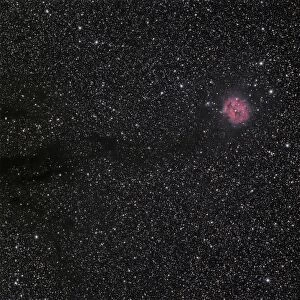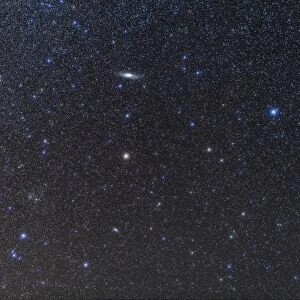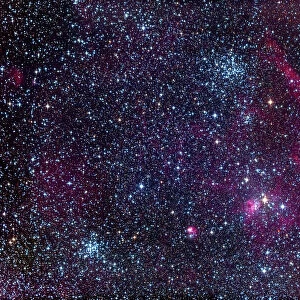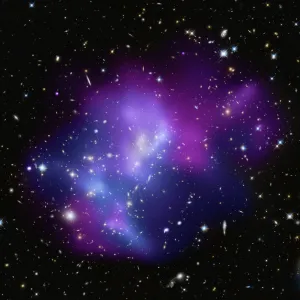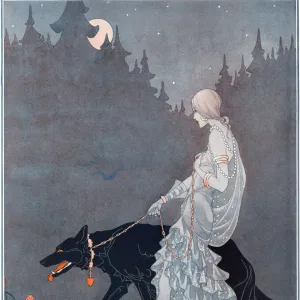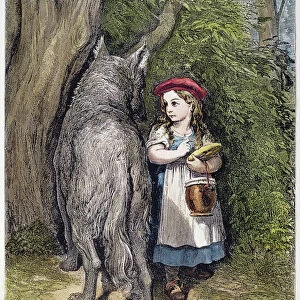Home > Animals > Mammals > Dogs (Wild) > Red Wolf
H II regions NGC 3603 and NGC 3576
![]()

Wall Art and Photo Gifts from Stocktrek
H II regions NGC 3603 and NGC 3576
NGC 3603 (left) and NGC 3576 (right) are two of the most luminous HII regions in our galaxy but their juxtaposition is really an illusion. The objects are physically unrelated, NGC 3603 being twice as far as NGC 3576. Although they appear side by side NGC 3603 is located in the carina arm of our galaxy while NGC 3576 resides in the Sagittarius arm. There are some similarities as both are undergoing a high rate of sequential star formation. NGC 3603, a Giant HII region is an extraordinary object. It is likely the most massive visible HII region in our galaxy extending at least 1000 light years across and containing the overall mass of 10, 000 suns. At its center is the extremely compact and bright cluster core, HD 97950 which contains at least 50 massive O type stars including several Wolf-Rayet types
Stocktrek Images specializes in Astronomy, Dinosaurs, Medical, Military Forces, Ocean Life, & Sci-Fi
Media ID 13060731
© Robert Gendler/Stocktrek Images
Astrophotography Beauty Bright Carina Cluster Core Cosmic Cosmic Dust Cosmology Emission Nebula Eta Carinae Galaxy Glow H Ii Regions Illuminated Interstellar Clouds Luminous Milky Way Nebula Nebular Nebulosity Nebulous Open Clusters Orange Sagittarius Star Clouds Star Clusters Star Formation Starfield Starforming Stellar Stellar Wind Two Objects Wolf Rayet Stars Evolution View From Space
FEATURES IN THESE COLLECTIONS
> Animals
> Mammals
> Dogs (Wild)
> Red Wolf
EDITORS COMMENTS
This print showcases the stunning H II regions NGC 3603 and NGC 3576, two luminous objects in our galaxy. However, their apparent juxtaposition is merely an illusion as they are physically unrelated. NGC 3603, located in the Carina arm of our Milky Way, is twice as far away from us compared to NGC 3576 residing in the Sagittarius arm. Both regions share similarities as they undergo a high rate of sequential star formation. The remarkable Giant H II region, NGC 3603, stands out with its extraordinary features. Spanning over 1000 light years across and containing a mass equivalent to that of 10,000 suns, it is likely the most massive visible H II region in our galaxy. At the heart of NGC 3603 lies the compact and brilliantly illuminated cluster core known as HD 97950. This core houses at least fifty massive O type stars including several Wolf-Rayet types. The vibrant colors emitted by these celestial bodies create a cosmic spectacle against the backdrop of interstellar clouds and dust. As we gaze upon this image captured by Robert Gendler through astrophotography techniques, we are reminded of the immense beauty and complexity present within our universe's starforming regions. It serves as a reminder that even though appearances can be deceiving when observing distant objects in space, their individual magnificence remains intact for us to admire from afar.
MADE IN THE USA
Safe Shipping with 30 Day Money Back Guarantee
FREE PERSONALISATION*
We are proud to offer a range of customisation features including Personalised Captions, Color Filters and Picture Zoom Tools
SECURE PAYMENTS
We happily accept a wide range of payment options so you can pay for the things you need in the way that is most convenient for you
* Options may vary by product and licensing agreement. Zoomed Pictures can be adjusted in the Cart.


